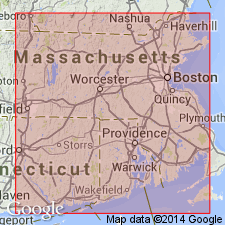
- Usage in publication:
-
- East Passage Formation
- Modifications:
-
- Original reference
- Dominant lithology:
-
- Phyllite
- Sandstone
- Siltstone
- AAPG geologic province:
-
- New England province
Summary:
Pg. 22 (table 2), 32 (fig. 7), 35. East Passage Formation. Mostly red, orange-brown, and gray-green phyllite, and thinly bedded, non-graded sandstone and siltstone. [Thickness not stated.] Probably fault bounded; in fault(?) contact with Lower Cambrian Pirate Cave Formation. May be equivalent of basal phyllites of Jamestown Formation of Conanicut Group (new). Fossils (trilobite PARADOXIDES identified by A.[R.] Palmer, personal commun., 1987). Age is considered Middle Cambrian, based on fossils and strong lithologic similarity to basal Jamestown.
[Type locality]: extensive series of outcrops on northwestern shore of Newport Neck [btw. Fort Adams and Castle Hill], adjacent to East Passage, [Newport 7.5-min quadrangle, Newport Co.], southern Narragansett Bay, southeastern RI.
Source: Publication.
For more information, please contact Nancy Stamm, Geologic Names Committee Secretary.
Asterisk (*) indicates published by U.S. Geological Survey authors.
"No current usage" (†) implies that a name has been abandoned or has fallen into disuse. Former usage and, if known, replacement name given in parentheses ( ).
Slash (/) indicates name conflicts with nomenclatural guidelines (CSN, 1933; ACSN, 1961, 1970; NACSN, 1983, 2005, 2021). May be explained within brackets ([ ]).

